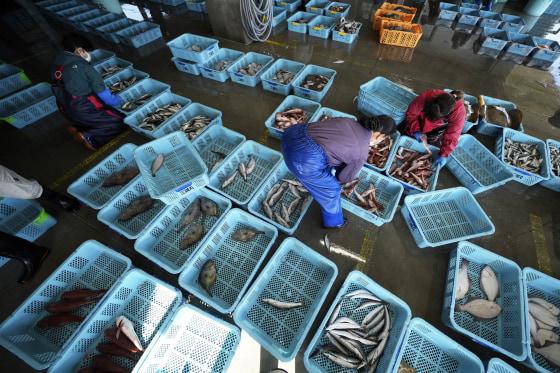Japan has officially resumed seafood exports to China for the first time in two years, following a suspension triggered by concerns over radioactive contamination after the Fukushima nuclear wastewater release. The decision marks a significant step in restoring trade relations between the two countries, as Tokyo seeks to assure consumers and trading partners of the safety of its seafood products amid lingering apprehensions. This development comes amid ongoing diplomatic and environmental discussions surrounding the aftermath of the 2011 Fukushima disaster.
Japan Restarts Seafood Shipments to China Signaling Diplomatic Thaw
The long-standing restrictions on seafood exports from Japan to China have been lifted, marking a significant step in the bilateral relationship between the two East Asian nations. This move comes nearly two years after Japan’s controversial decision to release treated radioactive wastewater from the Fukushima nuclear plant into the Pacific Ocean, which had soured diplomatic ties and halted trade. The resumption signifies a cautious trust rebuild and economic reconciliation, with both governments emphasizing rigorous safety inspections and transparency in seafood quality assurance.
Key points in the renewed trade agreement include:
- Enhanced monitoring programs for radiation levels in seafood products
- Regular joint inspections conducted by Chinese and Japanese authorities
- Commitment to sharing scientific data related to marine safety
- Gradual phased increase of seafood export quotas over the next 12 months
| Seafood Category | Safety Limit (Bq/kg) | China’s Import Quota |
|---|---|---|
| Tuna | 100 | 500 tons/month |
| Salmon | 100 | 300 tons/month |
| Scallops | 100 | 200 tons/month |
| Seaweed | 50 | 150 tons/month |
Analyzing Safety Measures and Environmental Monitoring Post Fukushima Discharge
Following the controversial release of treated Fukushima wastewater into the Pacific Ocean, Japanese authorities and international experts have implemented stringent safety protocols to monitor the environmental impact. Continuous testing focuses on key seafood species commonly exported to major markets, particularly China, ensuring radiation levels remain well below international safety thresholds. Enhanced surveillance includes real-time water quality analysis and comprehensive bioaccumulation studies, integrating data from both coastal monitoring stations and offshore vessels. Regulatory agencies emphasize transparency, publishing monthly reports that detail radionuclide concentrations and the effectiveness of filtration technologies applied before discharge.
Environmental monitoring extends beyond radiation, targeting overall ecosystem health to detect early signs of disruption. Collaborative efforts between Japan’s Ministry of Environment and independent scientific bodies have produced a multipronged approach to safeguard marine biodiversity, which includes:
- Periodic sampling of plankton, fish, and seaweed to track radioactive isotopes
- Remote sensing technologies to identify anomalies in water temperature and salinity
- Community-based feedback mechanisms reporting any unusual sightings or catches
| Parameter | Safety Limit | Current Average | Status |
|---|---|---|---|
| Cesium-137 (Bq/kg) | 100 | 5 | Within Limits |
| Water Tritium (Bq/L) | 60,000 | 10,000 | Within Limits |
| Seaweed Radioactivity (Bq/kg) | 200 | 15 | Within Limits |
Experts Urge Continued Transparency and Strengthened Bilateral Oversight Mechanisms
Following the resumption of Japan’s seafood exports to China, specialists emphasize the indispensability of continued transparency regarding environmental monitoring and food safety standards. They argue that sustained openness will be critical in rebuilding consumer trust on both sides and mitigating the lingering concerns associated with Fukushima’s wastewater discharge. Experts call for the establishment of robust bilateral mechanisms to ensure that every shipment adheres to strict safety protocols verified through independent assessments.
Key proposed measures include:
- Regular exchange of scientific data between Japan and China’s regulatory agencies
- Joint inspection teams conducting randomized seafood sampling at major export ports
- Real-time public reporting platforms to update stakeholders on contaminant levels
- Development of standard operating procedures for addressing any irregularities promptly
| Oversight Aspect | Proposed Action | Expected Outcome |
|---|---|---|
| Data Transparency | Open access to monitoring results | Greater public confidence |
| Joint Inspections | Collaborative sampling & testing | Enhanced verification accuracy |
| Communication | Real-time updates via platforms | Swift response to issues |
Wrapping Up
As Japan resumes seafood exports to China after a two-year suspension linked to concerns over the Fukushima wastewater release, both nations appear to be signaling a cautious step toward normalization in trade relations. While Japan maintains that its seafood products meet international safety standards, consumer confidence and diplomatic dynamics will continue to shape the trajectory of this renewed commercial engagement. Observers will be watching closely to see how this development influences broader regional cooperation and the future of bilateral trade.




